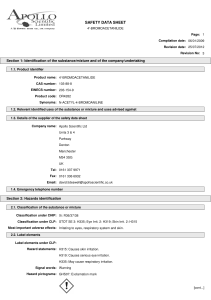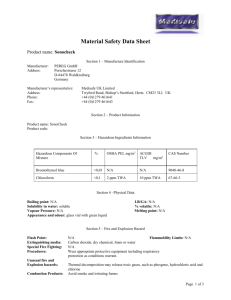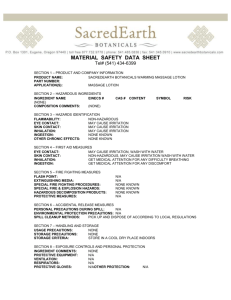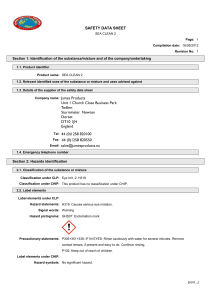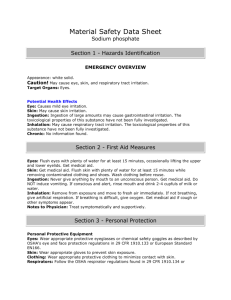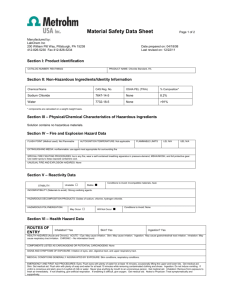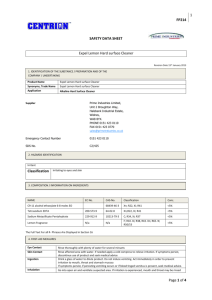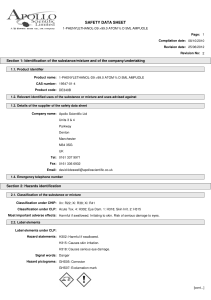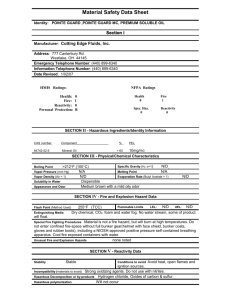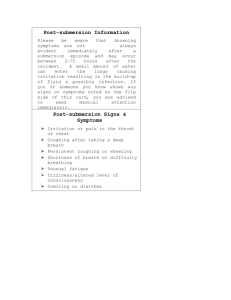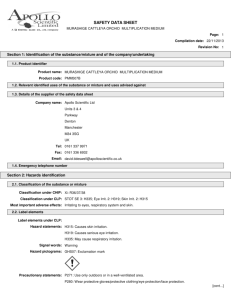as PDF - Apollo Scientific
advertisement
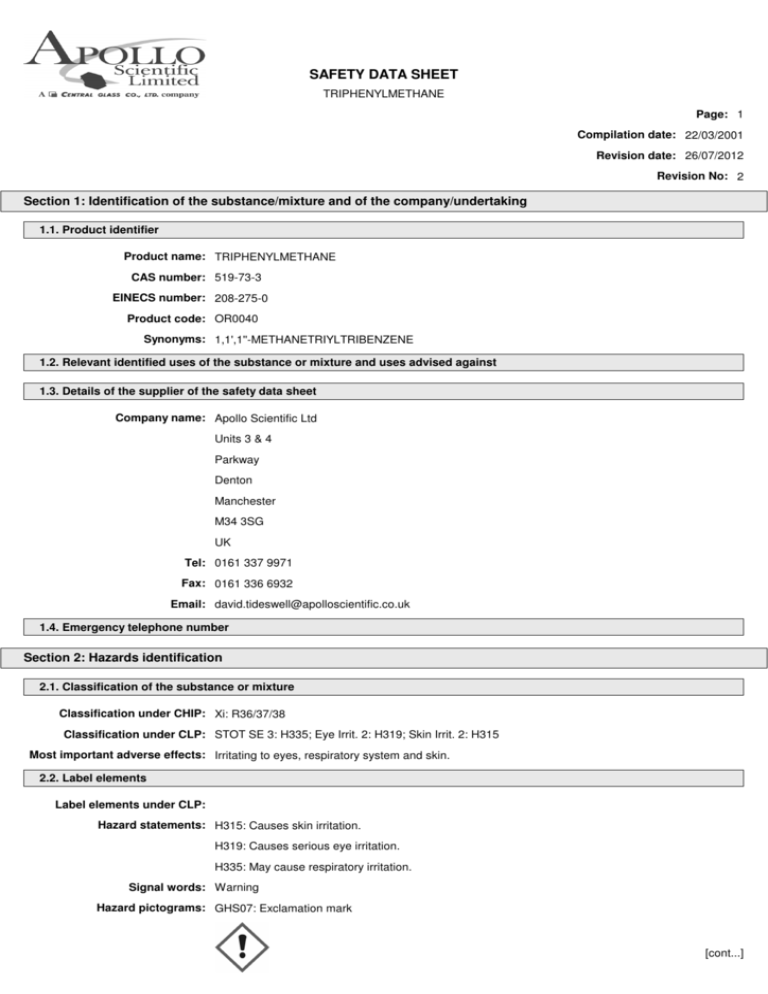
SAFETY DATA SHEET TRIPHENYLMETHANE Page: 1 Compilation date: 22/03/2001 Revision date: 26/07/2012 Revision No: 2 Section 1: Identification of the substance/mixture and of the company/undertaking 1.1. Product identifier Product name: TRIPHENYLMETHANE CAS number: 519-73-3 EINECS number: 208-275-0 Product code: OR0040 Synonyms: 1,1',1''-METHANETRIYLTRIBENZENE 1.2. Relevant identified uses of the substance or mixture and uses advised against 1.3. Details of the supplier of the safety data sheet Company name: Apollo Scientific Ltd Units 3 & 4 Parkway Denton Manchester M34 3SG UK Tel: 0161 337 9971 Fax: 0161 336 6932 Email: david.tideswell@apolloscientific.co.uk 1.4. Emergency telephone number Section 2: Hazards identification 2.1. Classification of the substance or mixture Classification under CHIP: Xi: R36/37/38 Classification under CLP: STOT SE 3: H335; Eye Irrit. 2: H319; Skin Irrit. 2: H315 Most important adverse effects: Irritating to eyes, respiratory system and skin. 2.2. Label elements Label elements under CLP: Hazard statements: H315: Causes skin irritation. H319: Causes serious eye irritation. H335: May cause respiratory irritation. Signal words: Warning Hazard pictograms: GHS07: Exclamation mark [cont...] SAFETY DATA SHEET TRIPHENYLMETHANE Page: 2 Precautionary statements: P261: Avoid breathing dust. P271: Use only outdoors or in a well-ventilated area. P280: Wear protective gloves/protective clothing/eye protection/face protection. Label elements under CHIP: Hazard symbols: Irritant. Risk phrases: R36/37/38: Irritating to eyes, respiratory system and skin. Safety phrases: S22: Do not breathe dust. S26: In case of contact with eyes, rinse immediately with plenty of water and seek medical advice. S36/37/39: Wear suitable protective clothing, gloves and eye / face protection. 2.3. Other hazards PBT: This substance is not identified as a PBT substance. Section 3: Composition/information on ingredients 3.1. Substances Chemical identity: TRIPHENYLMETHANE Section 4: First aid measures 4.1. Description of first aid measures Skin contact: Remove all contaminated clothes and footwear immediately unless stuck to skin. Wash immediately with plenty of soap and water. Eye contact: Bathe the eye with running water for 15 minutes. Consult a doctor. Ingestion: Wash out mouth with water. Consult a doctor. Inhalation: Remove casualty from exposure ensuring one's own safety whilst doing so. Consult a doctor. 4.2. Most important symptoms and effects, both acute and delayed Skin contact: There may be irritation and redness at the site of contact. Eye contact: There may be irritation and redness. The eyes may water profusely. Ingestion: There may be soreness and redness of the mouth and throat. Inhalation: There may be irritation of the throat with a feeling of tightness in the chest. Exposure may cause coughing or wheezing. 4.3. Indication of any immediate medical attention and special treatment needed Section 5: Fire-fighting measures [cont...] SAFETY DATA SHEET TRIPHENYLMETHANE Page: 3 5.1. Extinguishing media Extinguishing media: Carbon dioxide, dry chemical powder, foam. Suitable extinguishing media for the surrounding fire should be used. 5.2. Special hazards arising from the substance or mixture Exposure hazards: In combustion emits toxic fumes. Carbon oxides. 5.3. Advice for fire-fighters Advice for fire-fighters: Wear self-contained breathing apparatus. Wear protective clothing to prevent contact with skin and eyes. Section 6: Accidental release measures 6.1. Personal precautions, protective equipment and emergency procedures Personal precautions: Refer to section 8 of SDS for personal protection details. If outside do not approach from downwind. If outside keep bystanders upwind and away from danger point. Mark out the contaminated area with signs and prevent access to unauthorised personnel. Do not create dust. 6.2. Environmental precautions Environmental precautions: Do not discharge into drains or rivers. 6.3. Methods and material for containment and cleaning up Clean-up procedures: Transfer to a closable, labelled salvage container for disposal by an appropriate method. 6.4. Reference to other sections Section 7: Handling and storage 7.1. Precautions for safe handling Handling requirements: Avoid direct contact with the substance. Ensure there is sufficient ventilation of the area. Do not handle in a confined space. Avoid the formation or spread of dust in the air. Only use in fume hood. 7.2. Conditions for safe storage, including any incompatibilities Storage conditions: Store in cool, well ventilated area. Keep container tightly closed. Suitable packaging: Must only be kept in original packaging. 7.3. Specific end use(s) Specific end use(s): No data available. Section 8: Exposure controls/personal protection 8.1. Control parameters Workplace exposure limits: Not applicable. [cont...] SAFETY DATA SHEET TRIPHENYLMETHANE Page: 4 8.2. Exposure controls Engineering measures: Ensure there is sufficient ventilation of the area. Respiratory protection: Self-contained breathing apparatus must be available in case of emergency. Respiratory protective device with particle filter. Hand protection: Protective gloves. Eye protection: Safety glasses. Ensure eye bath is to hand. Skin protection: Protective clothing. Section 9: Physical and chemical properties 9.1. Information on basic physical and chemical properties State: Solid Colour: Yellow to brown Oxidising: Non-oxidising (by EC criteria) Solubility in water: Insoluble Boiling point/range°C: 358-359@754mmHg Melting point/range°C: 92-94 Relative density: 1.014 9.2. Other information Other information: Not applicable. Section 10: Stability and reactivity 10.1. Reactivity Reactivity: Stable under recommended transport or storage conditions. 10.2. Chemical stability Chemical stability: Stable under normal conditions. 10.3. Possibility of hazardous reactions Hazardous reactions: Hazardous reactions will not occur under normal transport or storage conditions. 10.4. Conditions to avoid Conditions to avoid: Heat. 10.5. Incompatible materials Materials to avoid: Strong oxidising agents. Strong acids. 10.6. Hazardous decomposition products Haz. decomp. products: In combustion emits toxic fumes of carbon dioxide / carbon monoxide. Section 11: Toxicological information 11.1. Information on toxicological effects [cont...] SAFETY DATA SHEET TRIPHENYLMETHANE Page: 5 Relevant hazards for substance: Hazard Route Basis Skin corrosion/irritation DRM Based on test data Serious eye damage/irritation OPT Based on test data STOT-single exposure INH Based on test data Symptoms / routes of exposure Skin contact: There may be irritation and redness at the site of contact. Eye contact: There may be irritation and redness. The eyes may water profusely. Ingestion: There may be soreness and redness of the mouth and throat. Inhalation: There may be irritation of the throat with a feeling of tightness in the chest. Exposure may cause coughing or wheezing. Section 12: Ecological information 12.1. Toxicity Ecotoxicity values: Not applicable. 12.2. Persistence and degradability Persistence and degradability: No data available. 12.3. Bioaccumulative potential Bioaccumulative potential: No data available. 12.4. Mobility in soil Mobility: No data available. 12.5. Results of PBT and vPvB assessment PBT identification: This substance is not identified as a PBT substance. 12.6. Other adverse effects Other adverse effects: No data available. Section 13: Disposal considerations 13.1. Waste treatment methods Disposal operations: MATERIAL SHOULD BE DISPOSED OF IN ACCORDANCE WITH LOCAL, STATE AND FEDERAL REGULATIONS Disposal of packaging: Dispose of as special waste in compliance with local and national regulations Observe all federal, state and local environmental regulations. NB: The user's attention is drawn to the possible existence of regional or national regulations regarding disposal. Section 14: Transport information [cont...] SAFETY DATA SHEET TRIPHENYLMETHANE Page: 6 14.1. UN number UN number: UNnone 14.2. UN proper shipping name Shipping name: NOT CLASSIFIED AS DANGEROUS IN THE MEANING OF TRANSPORT REGULATIONS. 14.3. Transport hazard class(es) 14.4. Packing group 14.5. Environmental hazards Environmentally hazardous: No Marine pollutant: No 14.6. Special precautions for user Section 15: Regulatory information 15.1. Safety, health and environmental regulations/legislation specific for the substance or mixture 15.2. Chemical Safety Assessment Chemical safety assessment: A chemical safety assessment has not been carried out for the substance or the mixture by the supplier. Section 16: Other information Other information Other information: This safety data sheet is prepared in accordance with Commission Regulation (EU) No 453/2010. * Data predicted using computational software. Toxtree - Toxic Hazard Estimation by decision tree approach. http://ecb.jrc.ec.europa.eu/qsar/qsar-tools/index.php? c=TOXTREE ~ Data predicted using computatioanl software ACD/ToxSuite v 2.95.1 Copyright 19942009 ACD/labs, Copyright 2001-2009 Pharma Algorithms, Inc, Advanced Chemistry Development, Inc (ACD/Labs). http://www.acdlabs.com/products/pc_admet/tox/tox/ Phrases used in s.2 and 3: H315: Causes skin irritation. H319: Causes serious eye irritation. H335: May cause respiratory irritation. R36/37/38: Irritating to eyes, respiratory system and skin. Legal disclaimer: The material is intended for research purposes only and should be handled exclusively by those who have been fully trained in safety, laboratory and chemical handling procedures. The above information is believed to be correct to the best of our knowledge. The above information is believed to be correct to the best of our knowledge at the date of its publication, but should not be considered to be all inclusive. It should be used only as a guide for safe handling, storage, transportation and disposal. We cannot guarantee that the hazards detailed in this document are the only hazards that [cont...] SAFETY DATA SHEET TRIPHENYLMETHANE Page: 7 exist for this product. This is not a warranty and Apollo Scientific Ltd shall not be held liable for any damage resulting from handling or from contact with the above product. [final page]
